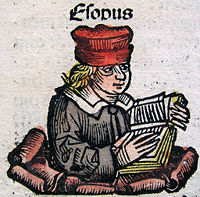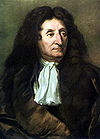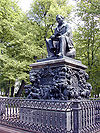Difference between revisions of "Fable" - New World Encyclopedia
| Line 25: | Line 25: | ||
:Animals with human characteristics: Fables frequently have as their central characters ''[[animal]]s'' that are given [[anthropomorph]]ic characteristics such as the ability to reason and speak. In [[classical antiquity|antiquity]], [[Aesop]]' fables presented a wide range of animals as [[protagonist]]s, including ''[[The Tortoise and the Hare]]'' which engage in a race against each other; and, in another classic fable, a fox which rejects grapes that are out of reach, as probably being sour ("[[sour grapes]]")(see example above). | :Animals with human characteristics: Fables frequently have as their central characters ''[[animal]]s'' that are given [[anthropomorph]]ic characteristics such as the ability to reason and speak. In [[classical antiquity|antiquity]], [[Aesop]]' fables presented a wide range of animals as [[protagonist]]s, including ''[[The Tortoise and the Hare]]'' which engage in a race against each other; and, in another classic fable, a fox which rejects grapes that are out of reach, as probably being sour ("[[sour grapes]]")(see example above). | ||
| − | :[[Personification]] may also be extended to ''[[inanimate|things inanimate]]'', as in | + | :[[Personification]] may also be extended to ''[[inanimate|things inanimate]]'', as in [[Ignacy Krasicki]]'s" |
| − | most noted work ''[[Fables and Parables]]''. | + | ''Bread and Sword'' from his most noted work ''[[Fables and Parables]]''. |
| + | |||
| + | :As the bread lay next to the sword, the weapon demurred: | ||
| + | :"You would certainly show me more respect if you heard | ||
| + | :How by night and by day I conscientiously strive | ||
| + | :So that you may safely go on keeping men alive." | ||
| + | :"I know," said the bread, "the shape of your duty's course: | ||
| + | :You defend me less often than you take me by force." | ||
| + | |||
| + | Many of Krasicki's fables and parable provided political and satirical commentary of the day in defense of the | ||
| + | |||
:''[[Gods|Divinities]]'' may also appear in fables as active agents. ''[[Aesop's Fables]]'' feature most of the Greek [[Pantheon (gods)|pantheon]], including [[Zeus]] and [[Hermes]]. | :''[[Gods|Divinities]]'' may also appear in fables as active agents. ''[[Aesop's Fables]]'' feature most of the Greek [[Pantheon (gods)|pantheon]], including [[Zeus]] and [[Hermes]]. | ||
Revision as of 19:02, 29 July 2008
- For other uses, see Fable (disambiguation).
A fable is a succinct story, in prose or verse, that employs the literary device, anthropomorphism - that is giving animals, plants, inanimate objects, or forces of nature, human attributes while expressing a simple moral or lesson. Examples abound in fables of talking animals that are whimsical, wise, or foolish creatures mimicking through their behavior our own human faults and foibles. A fable's moral lesson, sometimes must be inferred, but at other times it is expressed at the end of the story with a pithy saying or maxim. Often times a fable will have a "twist" or a surprise ending as well.
Fables, fairy tales, and parables all have in common the fact that they were handed down as an oral form of storytelling, sometimes recorded in writing much later than their time of actual creation. In such cases we might find traces of the historical record of traditions, beliefs and rites from bygone eras.[1]While fairy tales have fantastical elements, fables generally do not. Unlike fables, parables do not employ anthropomorphism, but rather characterize humans as they are.
Fables, whether ancient or modern, have been used to satirize social and political institutions of their day. An example of a modern day fable critiquing a social order would be George Orwell's Animal Farm (communism); one commenting on modern social mores is Richard Bach's Jonathan Livingston Seagull; Hans Christian Andersen's satirization of royalty in the nineteenth century with The Emperor's New Clothes is another. And The Wonderful Wizard of Oz written in 1900 by L. Frank Baum has the fantastical traits of a fairy tale (witches that fly, etc.) but it is also part fable having at least one anthropomorphic character (Cowardly Lion) and a moral at the end (There is no place like home).
A fable, while usually written as a child's story, conveys a simple lesson that can be appreciated by readers of all ages. Fables, both enjoyable and fun to read, can be an important part of a child's moral education especially when shared between parents and children.
Definitions
The word "fable" comes from the Latin "fabula" (a "story"). An author of fables is termed a fabulist. The word "fabulous," which comes from the word 'fable' now has a secondary meaning in the context of fables (ex), and is more informally used to mean, 'superb' or 'exceptional'.
An example of a fable would be the following story of The Fox and the Grapes[2]
One hot summer's day a Fox was strolling through an orchard till he came to a bunch of Grapes just ripening on a vine which had been trained over a lofty branch. "Just the thing to quench my thirst," quoth he. Drawing back a few paces, he took a run and a jump, and just missed the bunch. Turning round again with a One, Two, Three, he jumped up, but with no greater success. Again and again he tried after the tempting morsel, but at last had to give it up, and walked away with his nose in the air, saying: "I am sure they are sour."
- It is easy to despise what you cannot get.
Characteristics
Humor: Fables are a didactic mode of literature; that is their primary purpose is to instruct or guide, not just to entertain. However, fables also afford the reader an opportunity to laugh at human folly especially when they model examples of behaviors to be avoided rather than emulated.
- Animals with human characteristics: Fables frequently have as their central characters animals that are given anthropomorphic characteristics such as the ability to reason and speak. In antiquity, Aesop' fables presented a wide range of animals as protagonists, including The Tortoise and the Hare which engage in a race against each other; and, in another classic fable, a fox which rejects grapes that are out of reach, as probably being sour ("sour grapes")(see example above).
- Personification may also be extended to things inanimate, as in Ignacy Krasicki's"
Bread and Sword from his most noted work Fables and Parables.
- As the bread lay next to the sword, the weapon demurred:
- "You would certainly show me more respect if you heard
- How by night and by day I conscientiously strive
- So that you may safely go on keeping men alive."
- "I know," said the bread, "the shape of your duty's course:
- You defend me less often than you take me by force."
Many of Krasicki's fables and parable provided political and satirical commentary of the day in defense of the
- Divinities may also appear in fables as active agents. Aesop's Fables feature most of the Greek pantheon, including Zeus and Hermes.
Modern day fables:
History
The fable is one of the most enduring forms of folk literature, and can be found in the literature of almost every country.
Several parallel animal fables in Sumerian and Akkadian are among those that E. Ebeling
there are comparable fables from Egypt's Middle Kingdom,[3]
Hebrew fables such as the "king of trees" in Book of Judges 9 and "the thistle and the cedar tree" in II Kings 14:9.[4]
Hundreds of fables were composed in ancient India during the first millennium B.C.E., often as stories within frame stories. These included Vishnu Sarma's Panchatantra, the Hitopadesha, Vikram and The Vampire, and Syntipas' Seven Wise Masters, which were collections of fables that were later influential throughout the Old World. Earlier Indian epics such as Vyasa's Mahabharata and Valmiki's Ramayana also contained fables within the main story, often as side stories or back-story.
Epicharmus of Kos and Phormis are reported as having been among the first to invent comic fables.[5]
Fables had a further long tradition through the Middle Ages, and became part of European literature. During the 17th century, the French fabulist Jean de La Fontaine (1621-1695)
La Fontaine set out to satirize the court, the church, the rising bourgeoisie, indeed the entire human scene of his time. La Fontaine's model was subsequently emulated by Poland's Ignacy Krasicki (1735-1801) and Russia's Ivan Krylov (1769-1844).
In modern times it has also been fully adapted to modern adult literature. For instance, James Thurber used the ancient style in his books, Fables for Our Time and The Beast in Me and Other Animals. George Orwell's Animal Farm satirizes Stalinist Communism in particular, and totalitarianism in general, in the guise of animal fable.
The Medieval French fabliaux might feature Reynard the Fox, a trickster figure, and through its subtext give mild criticism to the feudal social order. Similarly, the 18th-century Polish fabulist Ignacy Krasicki employed animals as the title actors in his verse fable, "The Lamb and the Wolves."
Modern fabulists
- Leo Tolstoy (1828 – 1910).
- Nico Maniquis (1834 – 1912).
- Ambrose Bierce (1842 – ?1914).
- Sholem Aleichem (1859 – 1916).
- George Ade (1866 – 1944), Fables in Slang, etc.
- Don Marquis (1878 – 1937), author of the fables of archy and mehitabel.
- Franz Kafka (1883 – 1924).
- Damon Runyon (1884 – 1946).
- James Thurber (1894 – 1961), Fables For Our Time.
- George Orwell (1903 – 50).
- Dr. Seuss (1904 – 91)
- Isaac Bashevis Singer (1904 – 91).
- José Saramago (born 1922).
- Italo Calvino (1923 – 85), "If on a winter's night a traveler," etc.
- Arnold Lobel (1933 – 87), author of Fables, winner 1981 Caldecott Medal.
- Ramsay Wood (born 1943), author of Kalila and Dimna: Fables of Friendship and Betrayal.
- Bill Willingham (born 1956), author of Fables graphic novels.
- Acrid Hermit (born 1962), author of http://www.createspace.com/3340070" Misty Forest Fables. isbn 9781605859309
Classic fabulists
- Aesop (mid-6th century B.C.E.), author of Aesop's Fables.
- Vishnu Sarma (ca. 200 B.C.E.), author of the anthropomorphic political treatise and fable collection, the Panchatantra.
- Bidpai (ca. 200 B.C.E.), author of Sanskrit (Hindu) and Pali (Buddhist) animal fables in verse and prose.
- Syntipas (ca. 100 B.C.E.), Indian philosopher, reputed author of a collection of tales known in Europe as The Story of the Seven Wise Masters.
- Gaius Julius Hyginus (Hyginus, Latin author, native of Spain or Alexandria, ca. 64 B.C.E. - 17 C.E.), author of Fabulae.
- Phaedrus (15 B.C.E. – 50 C.E.), Roman fabulist, by birth a Macedonian.
- Walter of England c.1175
- Marie de France (12th century).
- Berechiah ha-Nakdan (Berechiah the Punctuator, or Grammarian, 13th century), author of Jewish fables adapted from Aesop's Fables.
- Robert Henryson (Scottish, 15th century), author of The Morall Fabillis of Esope the Phrygian.
- Leonardo da Vinci (Italian, 1452 – 1519).
- Biernat of Lublin (Polish, 1465? – after 1529).
- Jean de La Fontaine (French, 1621 – 95).
- John Gay (English) (1685 – 1732)
- Ignacy Krasicki (Polish, 1735 – 1801).
- Dositej Obradović (Serbian, 1742? – 1811).
- Félix María de Samaniego (Spanish, 1745 – 1801), best known for "The Ant and the Cicade."
- Tomás de Iriarte (Spanish, 1750 – 91).
- Ivan Krylov (Russian, 1769 – 1844).
Notable fables
- The Jataka Tales
- The Sky Is Falling
- Aesop's Fables by Aesop
- The Boy Who Cried Wolf
- Panchatantra by Vishnu Sarma
- Baital Pachisi (Vikram and The Vampire)
- Hitopadesha
- Seven Wise Masters by Syntipas
- Fables and Parables by Ignacy Krasicki
- Emperor's New Clothes
- Stone Soup
- The Little Engine that Could
- Jonathan Livingston Seagull
- Watership Down
- The Lion King
- The Fox and the Cock by James Thurber
- Animal Farm by George Orwell
- The Sun Girl and the Moon Boy (A Korean Folk tale) by Yangsook Choi
Notes
- ↑ http://www.lefavole.org/en/
- ↑ [1]
- ↑ E. Brunner-Traut, Altägyptische Tiergeschichte und Fabel (1970). Retrieved July 5, 2008.
- ↑ Both noted by Walter Burkert, The Orientalizing Revolution: Near Eastern Influence on Early Archaic Greek Culture (1992), p 121 note 4. Retrieved July 5, 2008.
- ↑ P.W. Buckham, p. 245. Retrieved July 5, 2008.
ReferencesISBN links support NWE through referral fees
- Brewer's dictionary of modern phrase & fable ISBN 0304353817
- The World Book Encyclopedia 2006. ISBN 0 716601060
External links
- Aesop's fables online collection Aesop's Fables.com Retrieved July 14, 2008.
- Fables - Collection and Guide to Fables for Children. Lefavole.org. Retrieved July 5, 2008.
- What is a Fable? About.com. Retrieved July 14, 2008.
- Native American Fables Retrieved July 14, 2008.
- aesopfables.com A Kidnapped Santa Claus by L. Frank Baum Retrieved July 19, 2008.
Credits
New World Encyclopedia writers and editors rewrote and completed the Wikipedia article in accordance with New World Encyclopedia standards. This article abides by terms of the Creative Commons CC-by-sa 3.0 License (CC-by-sa), which may be used and disseminated with proper attribution. Credit is due under the terms of this license that can reference both the New World Encyclopedia contributors and the selfless volunteer contributors of the Wikimedia Foundation. To cite this article click here for a list of acceptable citing formats.The history of earlier contributions by wikipedians is accessible to researchers here:
The history of this article since it was imported to New World Encyclopedia:
Note: Some restrictions may apply to use of individual images which are separately licensed.




